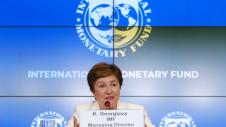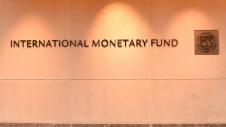Will Greek debt be sustainable after the pandemic, or will it need a restructuring or "haircut" again, in consultation with European creditors? This question, in the light of the new data created by the pandemic, came to the fore yesterday and brought back memories from the time of Europe's fierce dispute with the International Monetary Fund over debt sustainability. In fact, this debate is opening up a few weeks before the EU begins the difficult exercise of updating the Greek debt sustainability analysis.
The discussion on the Greek debt seemed to have closed in the summer of 2018, when, with the country leaving the bailout, terms on its relief were agreed upon.
Even after the outbreak of the pandemic, although the deficit soared and debt exceeded 200 percent of GDP in 2020, the general easing of fiscal rules in Europe and the catalytic intervention of the ECB, which brought its borrowing costs to historically low levels, eased concerns about its future sustainability.
At yesterday's Economist conference marking the 200th anniversary of the Greek Revolution, however, the Greek debt controversy flared up again. Paul Thomsen, the former head of the European IMF sector and architect of Greece’s stabilization program since 2010, predicted that after the pandemic, Greece will need, sooner or later, another debt restructuring, in contrast to Greek and European officials who stressed at the same event that Greek debt is sustainable.
In a panel consisting of former Euro Working Group President Thomas Wieser, who handled Greece's stabilization programs for a long time, Thomsen appeared extremely pessimistic.
Referring to debt sustainability, he described the European Commission's sustainability analyzes as being "incorrect and irrelevant", stressing that their aim was to show that Greek debt was sustainable over a very long horizon, based on overly optimistic assumptions about growth that are not consistent with the reality of progress on reforms.
According to the Danish economist, after the pandemic, Europe will sooner or later face a new debt crisis, as countries such as Italy or even France will have accumulated excessive debts. There will be a lot of pressure, he said, to write off the debt that was created during the pandemic period in the ECB's portfolio, and such pressures are already being exerted by Italy. In addition, the Recovery Fund will further increase government debt. In this context, Thomsen said that Greece will be a "sitting duck" that will simply wait for the next crisis. Private sector creditors know this will happen, but they do not care because they also know they will be rescued through a new intervention by European institutions, Thomsen said.
Thomas Wieser did not share Thomsen's pessimism, but declined to comment on his predictions for a new debt restructuring. Earlier, however, at the same event, a European response on the sustainability of Greek debt was given by the chief economist of the European Stability Mechanism, Rolf Strauch, who emphasized that show that analysis shows that Greek debt is sustainable.
For his part, Deputy Minister of Finance, Theodoros Skylakakis pointed out that the low cost of debt repayment is guaranteed. He noted that while there was uncertainty about the fiscal framework in place in Europe following the end of the suspension of fiscal rules, the government intends to meet the targets set at European level by taking a financially responsible stance.
Balancing act
The debate on the Greek debt and its viability is not only of a theoretical nature, since in the coming weeks EU technocrats will have to reopen the "Greek debt" chapter and update the sustainability analysis, in the context of the 10th post-memorandum evaluation from which, in fact, the next debt relief measures, amounting to 644 million euros (mainly profit returns from central banks), are expected to be released.
This exercise is not expected to lead to a shock, ie a conclusion that will challenge debt sustainability, on the one hand, because the lower borrowing costs of the country balance, to some extent, the expansion of deficits that have already taken place and the expected worsening of future economic performance. On the other hand, EU technocrats have serious political reasons to reach a positive conclusion, so as not to open a dangerous debate on the Greek debt now.
However, already from the sustainability analysis carried out at the end of 2020, it seemed that the pandemic crisis and the changes in the basic assumptions about the economic and budgetary quantities had significantly burdened the results of the sustainability analysis. It is can be seen that the deterioration in the fields of growth and primary fiscal balance causes several problems.
In particular, for 2020, the previous analysis showed that financing needs would reach 7.9 percent of GDP, but based on the new assumptions, they jumped to 20.1 percent of GDP. For 2021, from 4.8 percent they go up three times higher, to 15.9 percent. They also remain above the safety limit of 15 percent in 2022, to fall lower in 2023 and 2024. In all cases, however, by 2040 the borrowing needs are higher, compared to those estimated prior to the pandemic.
NONTAS HALDOYPIS









